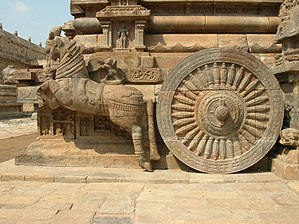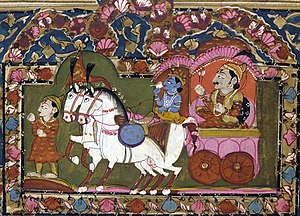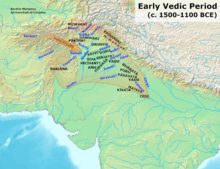History of the horse in the Indian subcontinent
The horse has been present in the Indian subcontinent from at least the middle of the second millennium BC,[1] more than two millennia after its domestication in Central Asia.[2] The earliest uncontroversial evidence of horse remains on the Indian Subcontinent date to the early Swat culture (around 1600 BCE). While horse remains and related artifacts have been found in Late Harappan (1900-1300 BCE) sites, indicating that horses may have been present at Late Harappan times,[3] horses did not play an essential role in the Harappan civilisation,[4] in contrast to the Vedic period (1500-500 BCE).[5] The importance of the horse for the Indo-Aryans is indicated by the Sanskrit word Ashva, "horse," which is often mentioned in the Vedas and Hindu scriptures.


Paleolithic
editDuring the Late Pleistocene, a species of equine, Equus namadicus, was native to the subcontinent, but it was extinct by the start of the Holocene.[6] Equus namadicus is considered a "stenonine horse", meaning that it is probably more closely related to zebras and asses than to true horses.[7]
Domestication
editDomestication of the horse before the second millennium BC appears to be confined to its native habitat, the Great Steppe. There is increasing evidence that horses were domesticated in the Eurasian Steppes around 3500 BC.[8][web 1][web 2] Recent discoveries in the context of the Botai culture suggest that Botai settlements in the Akmola Province of Kazakhstan are the location of the earliest domestication of the horse.[9]
Use of horses spread across Eurasia for transportation, agricultural work, and warfare. The horse only appears in Mesopotamia from around 1800 BC as a ridden animal and acquires military significance with the invention of the chariot.
Indus Valley Civilisation
editProponents of Indigenous Aryanism believe that the Indus Valley civilisation was Aryan and Vedic.[10] There are two common objections against such a correlation: "the Rg Vedic culture was pastoral and horse-centered, while the Harappan culture was neither horse-centered nor pastoral";[note 1][5] and "the complete absence of the modern horse (equus caballus)."[note 2] Support for the idea of an indigenous Indo-Aryan origin of the Indus Valley Civilisation mostly exists among Indian scholars of Hindu religion and the history and archaeology of India,[11][12][13][14] and has no support in mainstream scholarship.[note 3]
The paucity of horse remains in pre-Vedic times could be explained by India's climatic factors which lead to decay of horse bones. Horse bones may also be rare because horses were probably not eaten or used in burials by the Harappans.[15][16] Remains and artifacts ascribed to domesticated horses are limited to Late Harappan times[17][5][note 10] indicating that horses may have been present at Late Harappan times,[3] "when the Vedic people had settled in the north-west part of the subcontinent."[5] It can therefore not be concluded that the horse was regularly used, or played a significant role, in the Harappan society.[4]
Horse remains from the Harappan site Surkotada (dated to 2400-1700 BC) have been identified by A.K. Sharma as Equus ferus caballus.[subnote 3] The horse specialist Sandor Bökönyi (1997) later confirmed these conclusions, and stated the excavated tooth specimens could "in all probability be considered remnants of true horses [i.e. Equus ferus caballus]".[subnote 4] Bökönyi, as cited by B. B. Lal, stated that "The occurrence of true horse (Equus caballus L.) was evidenced by the enamel pattern of the upper and lower cheek and teeth and by the size and form of incisors and phalanges (toe bones)."[subnote 5] However, archaeologists like Meadow (1997) disagree, on the grounds that the remains of the Equus ferus caballus horse are difficult to distinguish from other equid species such as Equus asinus (donkeys) or Equus hemionus (onagers).[24]
Colin Renfrew (1999) remarked that "the significance of the horse [...] has been much exaggerated."[25][note 11]
Vedic period
edit
Sites such as the BMAC complex are at least as poor in horse remains as the Harappan sites.[11][note 12] The earliest undisputed finds of horse remains in South Asia are from the Gandhara grave culture, also known as the Swat culture (c. 1400–800 BCE),[5] related to the Indo-Aryans[27] and coinciding with their arrival in India.[28] Swat valley grave DNA analysis provides evidence of "connections between [Central Asian] Steppe population and early Vedic culture in India".[28]
Horses were important in the lifestyle of the Indo-Europeans.[29] Ashva, a Sanskrit word for a horse, is one of the significant animals referred to in the Vedas[30] and several other Hindu scriptures, and many personal names in the Rigveda are also centered on horses.[29] Derived from asva, its cognates are found in Indo-European languages like Sanskrit, Avestan, Latin and Greek (such as hippos and equus).[29] There are repeated references to the horse in the Vedas (c. 1500–500 BCE). In particular, the Rigveda has many equestrian scenes, often associated with chariots. The Ashvamedha or horse sacrifice is a notable ritual of the Yajurveda.
As horses were difficult to breed in the Indian climate, they were imported in large numbers, usually from Central Asia, but also from elsewhere. Horse traders are already mentioned in Atharvaveda 2.30.29. A painting at Ajanta shows horses and elephants that are transported by ship.[31] Trautmann (1982) thus remarked that the supply and import of horses has "always" been a preoccupation of the Indians, and "it is a structure of its history, then, that India has always been dependent upon western and central Asia for horses."[11]
See also
editNotes
editReferences
edit- ^ "Harappan horse myths and the sciences". The Hindu.
- ^ "Horse sense on Harappa: An excerpt from Tony Joseph's book "Early Indians"".
- ^ a b Bryant 2001, p. 270-271, 273.
- ^ a b Bryant 2001, p. 273.
- ^ a b c d e Reddy 2006, p. A93.
- ^ Jukar, A. M.; Lyons, S. K.; Wagner, P. J.; Uhen, M. D. (2021-01-15). "Late Quaternary extinctions in the Indian Subcontinent". Palaeogeography, Palaeoclimatology, Palaeoecology. 562: 110137. Bibcode:2021PPP...56210137J. doi:10.1016/j.palaeo.2020.110137. ISSN 0031-0182. S2CID 228877664.
- ^ Cirilli, Omar; Machado, Helena; Arroyo-Cabrales, Joaquin; Barrón-Ortiz, Christina I.; Davis, Edward; Jass, Christopher N.; Jukar, Advait M.; Landry, Zoe; Marín-Leyva, Alejandro H.; Pandolfi, Luca; Pushkina, Diana; Rook, Lorenzo; Saarinen, Juha; Scott, Eric; Semprebon, Gina (September 2022). "Evolution of the Family Equidae, Subfamily Equinae, in North, Central and South America, Eurasia and Africa during the Plio-Pleistocene". Biology. 11 (9): 1258. doi:10.3390/biology11091258. ISSN 2079-7737. PMC 9495906. PMID 36138737.
- ^ Matossian 2016, p. 43.
- ^ Outram 2009.
- ^ Bryant 2001, p. "It is claimed that the Aryans created the Harappan culture.".
- ^ a b c Bryant 2001.
- ^ Bryant & Patton 2005.
- ^ Singh 2008, p. 186.
- ^ a b Koenraad Elst (May 10, 2016), Koenraad Elst: "I am not aware of any governmental interest in correcting distorted history", Swarajya Magazine
- ^ Bryant 2001, p. 194.
- ^ S.P. Gupta. The dawn of civilization, in G.C. Pande (ed.)(History of Science, Philosophy and Culture in Indian Civilization, ed., D.P. Chattophadhyaya, vol I Part 1) (New Delhi:Centre for Studies in Civilizations, 1999)
- ^ Bryant 2001, p. 173.
- ^ S.R. Rao (1985) Lothal - A Harappan Port Town
- ^ "Horse Head". Museums of India. Retrieved 2020-11-12.
- ^ Piggott, Stuart (1970). "Copper Vehicle-Models in the Indus Civilization". Journal of the Royal Asiatic Society of Great Britain and Ireland. 102 (2): 200–202. doi:10.1017/S0035869X00128394. ISSN 0035-869X. JSTOR 25203212. S2CID 163967541.
- ^ Sali, S. A. "Daimabad : 1976-79". INDIAN CULTURE. p. 499. Retrieved 2020-08-12.
- ^ Singh, Upinder (2008). A History of Ancient and Early Medieval India: From the Stone Age to the 12th Century. Delhi: Pearson Education. pp. 229–233. ISBN 978-81-317-1120-0.
- ^ "Excavations - Important - Maharashtra". Archaeological Survey of India. Retrieved 1 September 2010.
- ^ Bryant 2001, pp. 169–175.
- ^ Bryant 2001, p. 120.
- ^ Thapar 1996, p. 21.
- ^ Kennedy 2012, p. 46.
- ^ a b Narasimhan et al. 2018.
- ^ a b c Reddy 2006, p. A-93.
- ^ www.wisdomlib.org (2021-08-27). "Rig Veda 10.75.8 [English translation]". www.wisdomlib.org. Retrieved 2023-02-17.
- ^ Himanshu Prabha Ray, Early Coastal Trade in the Bay of Bengal, In: Julian Reade (ed.) The Indian Ocean in Antiquity. London: Kegan Paul Intl. 1996
- ^ Thapar 2006.
- ^ Witzel 2001, p. 95.
Sources
edit- Printed sources
- Bryant, Edwin (2001). The Quest for the Origins of Vedic Culture. Oxford University Press. ISBN 0-19-513777-9.
- Bryant, Edwin F.; Patton, Laurie L. (2005). The Indo-Aryan Controversy: Evidence and Inference in Indian History. Routledge.
- Coomaraswamy, Ananda (1942). "Horse Riding in the Rgveda and Atharvaveda". Journal of the American Oriental Society. 62 (2). doi:10.2307/594467. JSTOR 594467.
- Falconer H. and Cautley, Fauna Antiqua Sivalensis, Being the Fossil Zoology of the Siwalik Highlands in the North of India, 1849, London.
- Kennedy, Kenneth A.R. (2000), God-Apes and Fossil Men: Palaeoanthropology of South Asia, Ann Arbor: University of Michigan Press
- Kennedy, Kenneth A.R. (2012), "Have Aryans been identified in the prehistorical skeletal record from South Asia? Biological anthropology and cocnepts of ancient races", in Erdosy, George (ed.), The Indo-Aryans of Ancient South Asia: Language, Material Culture and Ethnicity, Walter de Gruyter
- Lal, B.B. (1998). New Light on the Indus Civilization. Delhi: Aryan Books.
- Lal, B.B. (2005), The Homeland of the Aryans. Evidence of Rigvedic Flora and Fauna & Archaeology, New Delhi: Aryan Books International
- Matossian, Mary Kilbourne (2016), Shaping World History, Routledge, ISBN 978-1-315-50348-6
- Narasimhan, Vagheesh M.; Patterson, Nick J.; Moorjani, Priya; Lazaridis, Iosif; Mark, Lipson; Mallick, Swapan; Rohland, Nadin; Bernardos, Rebecca; Kim, Alexander M. (2018). "The Genomic Formation of South and Central Asia". bioRxiv: 292581. doi:10.1101/292581. hdl:21.11116/0000-0001-E7B3-0.
- Outram, Alan K.; et al. (2009). "The Earliest Horse Harnessing and Milking". Science. 323 (5919): 1332–1335. Bibcode:2009Sci...323.1332O. doi:10.1126/science.1168594. PMID 19265018. S2CID 5126719.
- Reddy, Krishna (2006), Indian History, Tata McGraw-Hill Education
- Singh, Upinder (2009), History of Ancient and Early Medieval India: From the Stone Age to the 12th Century, Longman, ISBN 978-8131716779
- Thapar (1996), The theory of Aryan race and India, Delhi: Social Scientist
- Thapar, Romila (2006). India: Historical Beginnings and the Concept of the Aryan. National Book Trust. ISBN 9788123747798.
- Trautmann, Thomas (2005), The Aryan Debate in India, Oxford University Press, ISBN 0-19-566908-8
- Witzel, Michael E. J. (2001). "Autochthonous Aryans? The Evidence from Old Indian and Iranian Texts" (PDF). Electronic Journal of Vedic Studies. 7 (3): 1–115.
- Web-sources
- ^ "What We Theorize – When and Where Domestication Occurred". International Museum of the Horse. Archived from the original on 19 July 2016. Retrieved 2015-01-27.
- ^ "Horsey-aeology, Binary Black Holes, Tracking Red Tides, Fish Re-evolution, Walk Like a Man, Fact or Fiction". Quirks and Quarks Podcast with Bob Macdonald. CBC Radio. 2009-03-07.
- ^ Chariots in the Chalcolithic Rock Art of Indian A Slide Show, Neumayer Erwin
- ^ Wendy Doniger (2017), "Another Great Story"", review of Asko Parpola's The Roots of Hinduism; in: Inference, International Review of Science, Volume 3, Issue 2
- ^ Girish Shahane (September 14, 2019), Why Hindutva supporters love to hate the discredited Aryan Invasion Theory, Scroll.in
Further reading
edit- Sandor Bököni (1997). "Horse Remains from the Prehistoric Site of Surkotada, Kutch, Late 3rd Millennium BC". South Asian Archaeology. 13: 297–307.
- Dallapiccola, Anna (26 November 2002). Dictionary of Hindu Lore and Legend. National Geographic Books. ISBN 0-500-51088-1.
- Kak, Subhash (2004). The Aśvamedha: The rite and its logic. Motilal Banarsidass. ISBN 9788120818774.
External links
edit